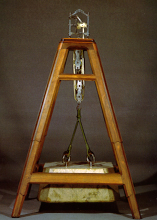
157.9 x 97.3 x 99
Iron, ivory, wood and marble
67 x 6.8
Steel and brass
INDEX 1788 : D.II.i.146
Parva Machina ferrea constans ex rota dentata et Cochlea sine fine. Haec Machina imponitur basi ligneae, ac adjuncto Polyspasto n.º 135 descriptio, lapidem 512 librarum pondo attollit, adhibita vi admodum exigua.
Small iron machine consisting of a cogwheel and a worm screw, placed on a wooden base; connected to the pulley described in n.º 135, it raises a stone weighing 512 pounds using a rather small force.
INDEX 1788 : E.I.135
Polyspaston ex octo orbiculis maioribus aequalibus compositum, qui pixidibus ex chalybe includuntur.
Block consisting of eight identical small wheels encased in steel loops.
This machine consists of an iron cogwheel with 42 teeth, turned by a worm screw which is activated by a crank. The axle of the cogwheel, 1.6 cm in diameter, functions as a winch where a rope is wound. The equipment rests on a four-legged wooden stand in the shape of a truncated pyramid, and is intended to lift heavy objects with little human effort.
The rope, wound around the axle of the cogwheel, passes through a block with four fixed and four moveable pulleys. This block is made up of two reels, one fixed and the other moveable, each consisting of four pulleys mounted on the same axle. A large stone is suspended from the lower set; the weight of this is the resistance which must be overcome.
It can be seen that the ratio between the crank arm (8.4 cm) and the radius of the cogwheel axle (0.8 cm) contributes a multiplication factor of 10.5. Each turn of the screw corresponds to four teeth of the cogwheel, which corresponds to a factor of 4. From the block with the four moveable pulleys, we have a factor of 8. Thus the total multiplication factor is 10.5 x 4 x 8 = 336, which means that to suspend a body weighing 336 kgf a force of 1 kgf must be applied to the end of the crank.
The stone is a block of marble, in the shape of a truncated pyramid with an octagonal base and alternate sides equal, weighing about 200 kg, with four hooks set into it. According to the University Account Books, cited by Rómulo de Carvalho in his História do Gabinete de Física da Universidade de Coimbra, a special cart was built to transport it.
However, the block of marble later disappeared from the collection of instruments, and was only rediscovered in 1936 in a country-house on the outskirts of Coimbra, where it was being used as an ornament, according to Professor Mário Silva ("Um novo museu in Coimbra: o Museu Pombalino da Faculdade da Ciências da Universidade", presented to the Lisbon Academy of Sciences in 1938).
The metalwork was made in Portugal, as can be seen by the inscription LIS. C. PIETRA.
In the Catalogue of Instruments of Colégio dos Nobres, the stand, the cogwheel, the worm screw and the piece of marble bear the number 137, while the pulley block is numbered 126.
Carvalho, Rómulo de, História do Gabinete de Física da Universidade de Coimbra, Universidade de Coimbra, Biblioteca Geral, Coimbra, 1978, pp. 256.
Silva, Mário da, "Um Novo Museu em Coimbra: O Museu Pombalino da Faculdade de Ciências da Universidade", Revista da Faculdade de Ciências da Universidade de Coimbra, Vol. VIII, n.º 1, pp. 129-154.